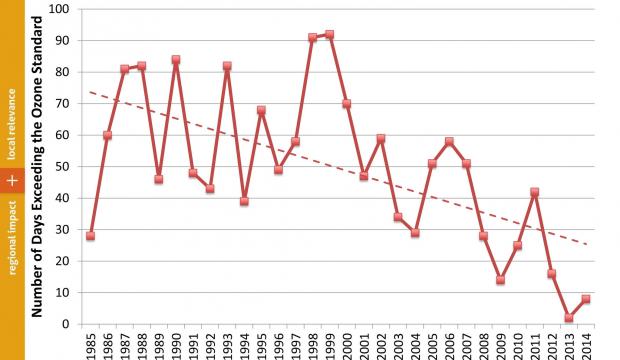|
Original article by Devin Henry:
http://thehill.com/policy/energy-environment/357162-epa-plans-to-streamline-air-pollution-permitting The Environmental Protection Agency (EPA) on Wednesday said it would reassess the way it issues Clean Air Act pollution permits for new facilities, as a way to reduce regulatory burdens for businesses. As part of a review President Trump mandated earlier this year, the EPA said it would undertake four new initiatives to re-evaluate how it regulates pollution. The most notable of those is the creation of a new task force to reconsider the permitting process for new sources of air pollution under the Clean Air Act, called the New Source Review (NSR). “The potential costs, complexity and delays that may arise from the NSR permitting process can slow the construction of domestic energy exploration, production, or transmission facilities that must undergo review,” the EPA wrote in a 15-page report on its regulations. “In some circumstances, the NSR process discourages the construction of new facilities or modifications of existing ones that could result in greater environmental improvements. Such reactions to the NSR process slows the growth of domestic energy resources and raise energy.” The EPA issues three types of permits for newly built or modified facilities such as power plants, which set site-specific pollution requirements. But commenters told the EPA the review process is lengthy, complex and costly, and suggested a handful of ways to improve the process. Administrator Scott Pruitt will convene an “NSR Reform Task Force” to assess the issue, the agency said. The new initiative comes after President Trump ordered agencies to consider ways to cut regulations and help the American energy sector. The Energy Department also released its regulatory review on Wednesday. Besides the new source considerations, the EPA said it would work to speed up its approval process for state plans aimed at reducing pollutants governed by the agency’s National Ambient Air Quality Standards, like ozone. It will also begin conducting an evaluation of the costs and employment impact of its regulations and designate a team of employees as points of contact to help industries navigate agency rulemaking. Both measures are likely to win praise within the business and energy communities.
2 Comments
Original Article:
https://www.epa.gov/newsreleases/air-quality-continues-improve-while-us-economy-continues-grow 08/02/2017 Contact Information: ([email protected])WASHINGTON – Today, the U.S. Environmental Protection Agency (EPA) released its annual report on air quality, showing the significant progress the United States has made to improve air quality across the country. “Our Nation’s Air: Status and Trends Through 2016” documents the steady and significant progress made in improving air quality across America, over more than 45 years under the Clean Air Act. This progress is often overlooked; the Association of Air Pollution Control Agencies has called it “The Greatest Story Seldom Told,” explaining that “Through the Clean Air Act’s framework of cooperative federalism, hard-working state and local air agencies have been responsible for tremendous progress in virtually every measure of air quality.” EPA’s most recent report highlights that, between 1970 and 2016, the combined emissions of six key pollutants dropped by 73 percent, while the U.S. economy grew more than three times. A closer look at more recent progress shows that between 1990 and 2016, national concentration averages of harmful air pollutants decreased considerably: • Lead (3-month average) ↓99 percent • Carbon monoxide (8-hour) ↓ 77 percent • Sulfur dioxide (1-hour) ↓ 85 percent • Nitrogen dioxide (annual) ↓ 56 percent • Ground-level ozone (8-hour) ↓ 22 percent • Coarse Particulate Matter (24-hour) ↓ 39 percent and Fine Particulate Matter (24-hour) ↓ 44 percent “Despite this success, there is more work to be done,” said EPA Administrator Scott Pruitt. “Nearly 40 percent of Americans are still living in areas classified as ‘non-attainment’ for failing to achieve national standards. EPA will continue to work with states, tribes, and local air agencies to help more areas of the country come into compliance.” This year’s update to the report includes new, interactive graphics that enable citizens, policymakers, and stakeholders to view and download detailed information by pollutant, geographic location, and time period. Explore the interactive report and download graphics and data here: https://gispub.epa.gov/air/trendsreport/2017/ To view the Association of Air Pollution Control Agencies' report: http://www.csg.org/aapca_site/documents/GreatestStory4-17-17.pdf Article by Robert Walton on UtilityDive:
http://bit.ly/2qbG0vW
WRAL.com reports the North Carolina Sustainable Energy Association believes the renewables standard has saved customers $162 million since it was approved in 2010. Strata Policy has estimated the mandates is costing about $3,500 per family. The proposed bill strikes language directing a renewables standard and instead says energy will be procured "in a manner that is consistent with the development of the least cost mix of generation." What is clear, however, is that renewable energy mandates and a decline in natural gas prices played a role in pushing out coal-fired generation. Coal-fired power plants provided more than half of the electricity generated in the state before 2012, but now that is less than a third according to the U.S. Energy Information Administration. On the other hand, renewable energy and natural gas generation increased rapidly. "The amount of electricity generated from solar energy in North Carolina has increased rapidly," EIA said. "With 2,294 megawatts, the state has the third-largest installed solar capacity in the nation." Wind energy is also growing in the state as federal agencies seek to open up offshore tracts to bidders. Last month, the Bureau of Ocean Energy Management announced it would lease 122,405 acres offshore North Carolina to Avangrid Renewables, for development of a wind energy facility off Kitty Hawk. It would be the company's second wind facility in the state; Avangrid previously developed the 208 MW Amazon Wind Farm. Original article by Richard M. Barron from the Winston-Salem Journal:
|
Archives
November 2017
|



 RSS Feed
RSS Feed